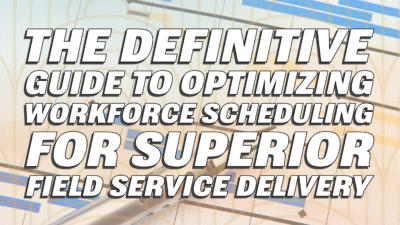Author: GDS
In today’s fast-paced, technology-driven world, the field service sector is not just about fixing problems; it’s about preempting them, solving them with unprecedented efficiency, and transforming those solutions into customer satisfaction and loyalty. Field technicians stand on the front lines of this transformation. Empowering these essential workers with cutting-edge tools and comprehensive training isn’t just an operational necessity—it’s a strategic imperative.
In today’s fast-paced, technology-driven world, the field service sector is not just about fixing problems; it’s about preempting them, solving them with unprecedented efficiency, and transforming those solutions into customer satisfaction and loyalty. Field technicians stand on the front lines of this transformation. Empowering these essential workers with cutting-edge tools and comprehensive training isn’t just an operational necessity—it’s a strategic imperative.
The Significance of Advanced Tools and Technologies
The introduction of advanced tools and technologies has revolutionized the way field technicians perform their duties. From mobile devices and apps that offer real-time data access and communication, to augmented reality (AR) that aids in complex repairs, the right tools can markedly improve productivity and efficiency. For instance, companies like GE Healthcare have leveraged AR glasses to provide remote assistance from experts to technicians on the field, significantly reducing downtime and enhancing service quality.
Continuous Training and Upskilling Strategies
The landscape of field service is continually evolving, with new technologies and methodologies emerging at a rapid pace. It’s crucial for field technicians to stay ahead of these changes. Continuous training and upskilling play a pivotal role in maintaining high industry standards. Techniques such as microlearning—short, targeted learning sessions—and gamified learning can increase engagement and retention of information, exemplified by Siemens’ comprehensive training programs that cover everything from safety standards to the latest technologies.
Empowerment in Action: Real-World Examples
Take Caterpillar Inc., for example, which has effectively empowered its field technicians through the Cat® App and remote monitoring technologies, allowing for preemptive maintenance and swift issue resolution. Another example is Honeywell, which introduced the Honeywell Forge platform, equipping its technicians with predictive analytics tools that drive operational performance and efficiency.
Collaboration and Support Ecosystem
Successful empowerment of field technicians is not just about individual prowess but also about fostering collaboration. Creating a supportive ecosystem where technicians, managers, and technology providers work together ensures that technical knowledge is shared, challenges are promptly addressed, and innovative solutions are collectively pursued. This collaborative approach is evident in how Bosch Rexroth integrates feedback from its field service into product development processes, enhancing both service quality and product innovation.
Financial Benefits of Empowerment
Investing in the empowerment of field technicians transcends operational benefits; it has a direct impact on the bottom line. Companies that prioritize high-quality tools and training for their technicians often see a reduction in service costs, fewer errors, and increased efficiency, ultimately leading to higher customer satisfaction and loyalty. Quantitatively, businesses like Xerox have reported substantial cost savings and increased revenue, attributing these results to their focus on technician empowerment and customer-centric strategies.
The Significance of Advanced Tools and Technologies
The introduction of advanced tools and technologies has revolutionized the way field technicians perform their duties. From mobile devices and apps that offer real-time data access and communication, to augmented reality (AR) that aids in complex repairs, the right tools can markedly improve productivity and efficiency. For instance, companies like GE Healthcare have leveraged AR glasses to provide remote assistance from experts to technicians on the field, significantly reducing downtime and enhancing service quality.
Continuous Training and Upskilling Strategies
The landscape of field service is continually evolving, with new technologies and methodologies emerging at a rapid pace. It’s crucial for field technicians to stay ahead of these changes. Continuous training and upskilling play a pivotal role in maintaining high industry standards. Techniques such as microlearning—short, targeted learning sessions—and gamified learning can increase engagement and retention of information, exemplified by Siemens’ comprehensive training programs that cover everything from safety standards to the latest technologies.
Empowerment in Action: Real-World Examples
Take Caterpillar Inc., for example, which has effectively empowered its field technicians through the Cat® App and remote monitoring technologies, allowing for preemptive maintenance and swift issue resolution. Another example is Honeywell, which introduced the Honeywell Forge platform, equipping its technicians with predictive analytics tools that drive operational performance and efficiency.
Collaboration and Support Ecosystem
Successful empowerment of field technicians is not just about individual prowess but also about fostering collaboration. Creating a supportive ecosystem where technicians, managers, and technology providers work together ensures that technical knowledge is shared, challenges are promptly addressed, and innovative solutions are collectively pursued. This collaborative approach is evident in how Bosch Rexroth integrates feedback from its field service into product development processes, enhancing both service quality and product innovation.
Financial Benefits of Empowerment
Investing in the empowerment of field technicians transcends operational benefits; it has a direct impact on the bottom line. Companies that prioritize high-quality tools and training for their technicians often see a reduction in service costs, fewer errors, and increased efficiency, ultimately leading to higher customer satisfaction and loyalty. Quantitatively, businesses like Xerox have reported substantial cost savings and increased revenue, attributing these results to their focus on technician empowerment and customer-centric strategies.
Conclusion
The pivotal role of field technicians in today’s service-oriented landscape cannot be overstated. By arming these valuable professionals with advanced tools and ongoing training, businesses can not only keep pace with industry evolution but also pave the way for innovation and growth. It’s clear that the future of field service management will be defined by how well we support and empower those who represent our companies in the field every day. The time to invest in your field teams is now, setting the stage for operational excellence and continued success.
The dialogue around the empowerment of field technicians is ongoing, and the strategies highlighted herein provide a solid foundation for businesses ready to elevate their service offerings. Make empowering your technicians a priority and watch as they drive your business to new heights of efficiency, customer satisfaction, and profitability.
Conclusion
The pivotal role of field technicians in today’s service-oriented landscape cannot be overstated. By arming these valuable professionals with advanced tools and ongoing training, businesses can not only keep pace with industry evolution but also pave the way for innovation and growth. It’s clear that the future of field service management will be defined by how well we support and empower those who represent our companies in the field every day. The time to invest in your field teams is now, setting the stage for operational excellence and continued success.
The dialogue around the empowerment of field technicians is ongoing, and the strategies highlighted herein provide a solid foundation for businesses ready to elevate their service offerings. Make empowering your technicians a priority and watch as they drive your business to new heights of efficiency, customer satisfaction, and profitability.
Get Started now with GDS!
Ready to unlock the full potential of your field technicians? Contact us today to learn more about our innovative tools and solutions designed to empower and support your field teams. Let’s work together to drive your business towards operational excellence and achieve greater success in the competitive service landscape. So, don’t wait any longer, take action now! Incorporate these strategies into your business and see the positive impact on your field service operations. Your technicians are the face of your company, so invest in their empowerment and watch as they take your business to new heights! Contact us today to get started.
Get Started now with GDS!
Ready to unlock the full potential of your field technicians? Contact us today to learn more about our innovative tools and solutions designed to empower and support your field teams. Let’s work together to drive your business towards operational excellence and achieve greater success in the competitive service landscape. So, don’t wait any longer, take action now! Incorporate these strategies into your business and see the positive impact on your field service operations. Your technicians are the face of your company, so invest in their empowerment and watch as they take your business to new heights! Contact us today to get started.
The Crucial Role of Real-Time Data in Field Service Operations
Author: GDS In our rapidly evolving landscape, a field service...
Read MoreEmpowering Your Field Technicians with the Right Tools and Training
Author: GDS In today’s fast-paced, technology-driven world, the field service...
Read MoreThe Evolution of Field Service: The Unstoppable Rise of On-Demand and Predictive Maintenance
Author: GDS In the rapidly evolving landscape of field services,...
Read MoreThe Definitive Guide to Optimizing Workforce Scheduling for Superior Field Service Delivery
Author: GDS In the demanding landscape of field service management,...
Read More
















